We have a big solar system, and as near as we can tell, we have it all to ourselves. So, there's lots of room for adventures both big and small, and you don't need warp drives, stargates, or lightsabers. As you might expect, I'm a big fan of what Clark Lindsey over at HobbySpace (which is the best space site on the Internet, IMHO) calls "Solar Sci-Fi": science fiction set in the context of near term solar system exploration and settlement. Unfortunately, there really haven't been that many games about real-world space exploration and development. Nevertheless, there have been some great space exploration titles released over the past two decades. Let's rocket down memory lane to see my favorites. I'll confine this list to PC games, not just nifty computer toys like the Virtual International Space Station. That's a topic for a another post. There's also a comprehensive list of space-related software over at HobbySpace, which is definitely worth looking at if you're interested in finding other software packages of this nature. Plus, there's a chance that I missed a good one-if I did, let me know!
Project Space Station: (abandonware; available from the Home of the Underdogs)
Modern updates: Shorthike (shareware, limited demo available)
 This was the computer game that I wanted to play back in 1984 (well, besides Star Raiders). It was available for both the Apple II and the IBM-PC AT (I played it at a friend's house) platform. Of course, I didn't replace my trusty Atari 800 with a PC AT until 1990, so I missed out. Thanks to the Home of the Underdogs and DOSBox, however, I've had a chance to try this title again.
This was the computer game that I wanted to play back in 1984 (well, besides Star Raiders). It was available for both the Apple II and the IBM-PC AT (I played it at a friend's house) platform. Of course, I didn't replace my trusty Atari 800 with a PC AT until 1990, so I missed out. Thanks to the Home of the Underdogs and DOSBox, however, I've had a chance to try this title again.
 Project: Space Station is still hailed as one of the best space exploration games ever produced. It succeeds because it distills what is a very complex enterprise - the design, construction, and operation of a space station in low earth orbit - down to the fun essentials. It was designed by Larry Holland (of SWoTL, X-Wing, and Bridge Commander fame) and displays the same characteristic attention to detail displayed in those later titles. Holland received a lot of help and support from NASA, and it shows.
Project: Space Station is still hailed as one of the best space exploration games ever produced. It succeeds because it distills what is a very complex enterprise - the design, construction, and operation of a space station in low earth orbit - down to the fun essentials. It was designed by Larry Holland (of SWoTL, X-Wing, and Bridge Commander fame) and displays the same characteristic attention to detail displayed in those later titles. Holland received a lot of help and support from NASA, and it shows.
The player is the executive in charge of managing the construction of NASA's first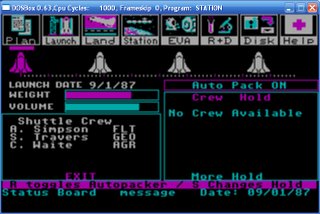 permanent space station in low earth orbit. The player must hire astronauts, select a space station design, purchase station components, manage a budget, and select which experiments to perform. You have simplified options that accurately reflect real-world choices. Never has managing a large multibillion dollar project been so fun! The goal, of course, is to eventually build up a large orbital outpost that pays for itself with useful research, on-orbit capabilities, and profitable discoveries.
permanent space station in low earth orbit. The player must hire astronauts, select a space station design, purchase station components, manage a budget, and select which experiments to perform. You have simplified options that accurately reflect real-world choices. Never has managing a large multibillion dollar project been so fun! The goal, of course, is to eventually build up a large orbital outpost that pays for itself with useful research, on-orbit capabilities, and profitable discoveries.
In addition to managing the project, the player is also placed in control of the STS missions to the station. You have to guide your Orbiter to the proper orbit, correctly assemble the station components, guide the offloading of supplies, and then return the  orbiter safely to earth. It sounds complicated, but it's actually a lot of fun. This really isn't a flightsim (not that flight sims aren't fun!), but more of a simplified representation of things that in real life are pretty hard to do successfully. The closest analog that I can think of to these parts of the game is actually Star Control's marvelously fun overhead space combat and movement interface. When you put it together, you have a fun-filled but downright educational game that is a blast to play. This is the way that the last twenty years in space should have happened. It is a real shame that the ISS is just a pale shadow of these ambitious 1980s plans for the Free World's first permanent space outpost. If things had worked out just a little differently, it really would have been like Project: Space Station.
orbiter safely to earth. It sounds complicated, but it's actually a lot of fun. This really isn't a flightsim (not that flight sims aren't fun!), but more of a simplified representation of things that in real life are pretty hard to do successfully. The closest analog that I can think of to these parts of the game is actually Star Control's marvelously fun overhead space combat and movement interface. When you put it together, you have a fun-filled but downright educational game that is a blast to play. This is the way that the last twenty years in space should have happened. It is a real shame that the ISS is just a pale shadow of these ambitious 1980s plans for the Free World's first permanent space outpost. If things had worked out just a little differently, it really would have been like Project: Space Station.
You can get the game working easily using the excellent Dfend/DOSBox combo, so I would 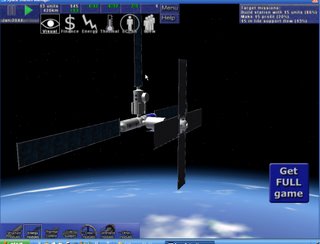 heartily encourage everyone to download and try this gem.
heartily encourage everyone to download and try this gem.
Nobody has ever tried to do a modern version of this game, although ShortHike (formerly Space Station Manager) is a good, SimCity style shareware space station construction program where you get to design, construct, and manage an orbital outpost with really snazzy 3-d graphics. You can download the demo for ShortHike here.
Shuttle: (Abandonware; Available from the Home of the Underdogs)
Modern Update: S3
I'm actually quite surprised that none of the big simulation firms (Dynamix, Jane's, Microsoft, etc.) ever tried to do a Space Shuttle simulator, because the Shuttle is a great topic for a computer game. One probably would have happened eventually if the Flightsim bubble hadn't burst (Dynamix, MicroProse, and Jane's are no more, and Microsoft seems to be abandoning the PC as a gaming platform) in the late nineties. Shuttle: The Space Flight Simulator, a 1992 offering from Virgin Games, is to my knowledge the last full, commercially available PC game about the Space Shuttle. It did an amazing job of distilling the most complex machine ever constructed to 3 1.2 MB floppy disks. It was a little skimpy on the tutorials, but it did offer a mode that guided you to the proper switches on the command deck, handy for those of us with out four years of astronaut training. It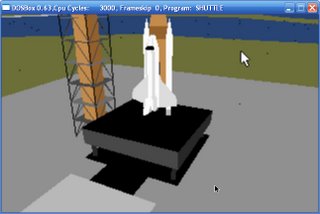 also offered a somewhat-confusing-but-OK- when-you-got-used-to-it "Time Skip" feature that let you skip to the next mission event, so you weren't expected to do the mission in real time. In principle, you could even do an automated skip to the end of the mission, but the landings (which, when you're flying the world's heaviest glider hypersonically at a trajectory seven times steeper than a commercial jetliner's, are quite challenging) had to be done manually.
also offered a somewhat-confusing-but-OK- when-you-got-used-to-it "Time Skip" feature that let you skip to the next mission event, so you weren't expected to do the mission in real time. In principle, you could even do an automated skip to the end of the mission, but the landings (which, when you're flying the world's heaviest glider hypersonically at a trajectory seven times steeper than a commercial jetliner's, are quite challenging) had to be done manually.
Of course, the nuts and bolts of any simulation game are the missions. You followed a linear mission track, starting with a 1977 Approach and Landing Test, then proceeding to the orbital flight tests, then satellite deployment, EVAs, Hubble deployment, satellite 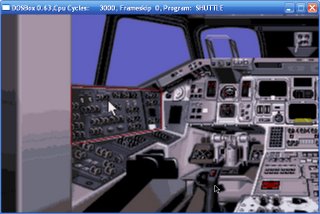 rescue, MMU testing, spy sat missions, and Space Station construction. Each mission was interesting, but the on-orbit space operations (doing EVAs and using the Canadarm) were fascinating.
rescue, MMU testing, spy sat missions, and Space Station construction. Each mission was interesting, but the on-orbit space operations (doing EVAs and using the Canadarm) were fascinating.
I'd love to say that I completed every mission, but I didn't. I got up to the Hubble deployment mission, but when I got into orbit and tried to deploy the Hubble, I encountered a nasty bug: Mission Control told me that it was going to take approximately 3,000 years for my cargo bay doors to open. D'oh! I never got to the nifty Station construction missions at the end. This bug was 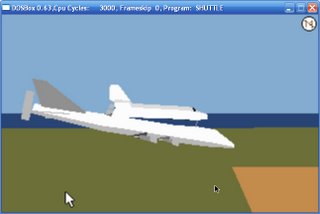 fixed by a patch that I was never able to obtain (and haven't been able to find since) because Virgin Games went out of business. This game runs reasonably well using DosBOX and it's available from the Home of the Underdogs if you want to give it a try, but there are some better options available currently.
fixed by a patch that I was never able to obtain (and haven't been able to find since) because Virgin Games went out of business. This game runs reasonably well using DosBOX and it's available from the Home of the Underdogs if you want to give it a try, but there are some better options available currently.
I've never tried it (I'm a Microsoft Flight Simulator guy, myself) but the X-Plane flightsim has a mode where you can perform a Shuttle reentry and landing, thanks to its spiffy computational fluid dynamics coding (SpaceShipOne's pilots and designers used a version of  X-Plane for training and testing, it's CFD codes are that good).
X-Plane for training and testing, it's CFD codes are that good).
The best bets are probably the extensive Shuttle Mods for Orbiter Space Flight Simulator; Eugene Harm also has a great guide to getting the Shuttle working in Orbiter here. Orbiter's large and active fan community is constantly upgrading and improving these mod packages. They're already pretty good, and I fully expect someone to use Orbiter to complete a top-to-bottom Shuttle simulation experience within a few years.
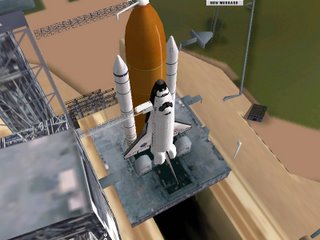 Finally, there's the Space Shuttle Simulator (screencap at left), an ambitious attempt to update the Virgin Games offering discussed above with modern graphics and interface. A beta version is available, and although the designer admits it's only 10% complete it already looks really promising. It's definitely worth the download.
Finally, there's the Space Shuttle Simulator (screencap at left), an ambitious attempt to update the Virgin Games offering discussed above with modern graphics and interface. A beta version is available, and although the designer admits it's only 10% complete it already looks really promising. It's definitely worth the download.
Buzz Aldrin's Race into Space (Abandonware)
 Well, as regular readers of this blog undoubtedly have figured out by now, I'm a big, huge fan of BARIS, which is still the most unique and creative strategy games ever done. I won't rehash what I said previously, but I will point you to Leon's "Buzz Aldrin's Race Into Space" Page, which is the best BARIS resource on the Net and includes the patch for the DOS version as well as a detailed guide to getting the game working in DOSBox using Dfend as well as disk images of the superior CD-ROM version of the game. I've gotten the DOS version working well in DOSBox, but I haven't been able to get my old CD-ROM version to work yet. Nevertheless, I really, really, really encourage everyone to try this game at least once.
Well, as regular readers of this blog undoubtedly have figured out by now, I'm a big, huge fan of BARIS, which is still the most unique and creative strategy games ever done. I won't rehash what I said previously, but I will point you to Leon's "Buzz Aldrin's Race Into Space" Page, which is the best BARIS resource on the Net and includes the patch for the DOS version as well as a detailed guide to getting the game working in DOSBox using Dfend as well as disk images of the superior CD-ROM version of the game. I've gotten the DOS version working well in DOSBox, but I haven't been able to get my old CD-ROM version to work yet. Nevertheless, I really, really, really encourage everyone to try this game at least once.
Microsoft Space Simulator (Abandonware; Available at the Home of the Underdogs, but good luck getting it to work)
Microsoft Space Simulator was a very special game that was produced by the same folks behind Microsoft Flight Simulator. MSSS realistically simulated a space flight experience. It was a true simulator in the sense that it basically lacked a plot or narrative structure (although there were missions you could accomplish), instead letting the user completely define the experience. That's OK, because the scope of this game was infinite. You could do literally anything that you could imagine: launch a Space Shuttle to Space Station Freedom, land the lunar module Challenger at the Apollo 17 landing site in the Taurus-Littrow valley, land at a Martian base, take a space freighter to Pluto, take an interstellar ship to a nearby star system, or take a Bussard ramscoop to the edge of the galaxy.
There were also prepackaged missions that you could use to get started, such as doing an Apollo CSM-Lunar Module rendezvous in Lunar Orbit. You had a wide variety of realistic space vehicles at your disposal, which were all things that could be built using real-world engineering principles. Although everything was simulated using Newtonian physics, you didn't have to worry about celestial mechanics if you didn't want to, because there was a fully functional autopilot that could take you wherever you wanted to go. That feature alone, in my opinion, is a significant advantage that this 1994 title has over its spiritual successor, the Orbiter Space Flight Simulator.
The folks who bought this game loved it, but the sales still fell short of Microsoft's expectations. It was so far afield of a conventional flightsim (airplanes and spacecraft are actually quite different from one another) that the flightsim crowd never warmed to it, and folks who like their adventures spoon-fed to them Star Wars-style couldn't handle the fact that there wasn't a Privateer-style plot. That was apparently enough to convince Microsoft to abandon an updated Windows 95 version of the game that I heard was nearly completed by the time of cancellation, which is truly unfortunate. This game deserved better.
You've probably noticed that I haven't posted any of the spectacular vistas that you could see in this game (fortunately, there are lots of screen caps over at Microsoft Space Simulator Central; head over there for a look). That's because the DOS version, which is available from the Home of the Underdogs, is notoriously finicky with Windows. In fact, this is the last DOS program ever released by Microsoft, and it seems downright determined to not work with modern Windows systems. I could get it running well with Windows 98, but since that point I haven't had any luck getting it to work. I got it working with Windows 2000 once, but I forgot to write those steps down (D'oh!) and have never gotten it to work again (despite an awful lot of trying) in XP. I couldn't even get it working with DOSBox (which says a lot about how finicky it is). There are some posts in the DOSBox forums describing how some of those folks were able to get it working with DOSBox (although none of those suggestions worked in my case). There are also some detailed setup suggestions at the “Microsoft Space Simulator: A View from a Fan” page and some other neat stuff (including screen caps) at Microsoft Space Simulator Central. Definitely worth a download and a few minutes of configuration twiddling—the results are worth it if you can get it working.
Eagle Lander 3D (Shareware, available from http://eaglelander3d.com; Full version requires license)
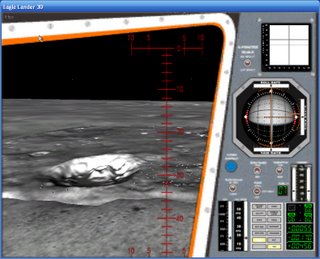 Well, July 20, 2006 isn't that far away. What better way to celebrate Apollo Day than by actually recreating humanity's first steps into the cosmic ocean yourself? You can do that, and more, with Ron Monsen's outstanding shareware flightsim Eagle Lander 3D. It displays a simply astonishing level of quality. The 3d-accelerated graphics are spectacular, including a fully-modeled virtual cockpit of the LM. The full version lets you do all kinds of cool things, including the landings at the Apollo 11 (Sea of Tranquility), 12 (Ocean of Storms), 15 (Hadley-Apennine), 17 (Taurus-Littrow) sites, as well as an LM racing course and a complete descent from lunar orbit.
Well, July 20, 2006 isn't that far away. What better way to celebrate Apollo Day than by actually recreating humanity's first steps into the cosmic ocean yourself? You can do that, and more, with Ron Monsen's outstanding shareware flightsim Eagle Lander 3D. It displays a simply astonishing level of quality. The 3d-accelerated graphics are spectacular, including a fully-modeled virtual cockpit of the LM. The full version lets you do all kinds of cool things, including the landings at the Apollo 11 (Sea of Tranquility), 12 (Ocean of Storms), 15 (Hadley-Apennine), 17 (Taurus-Littrow) sites, as well as an LM racing course and a complete descent from lunar orbit.
The evaluation version can be downloaded for free and includes a complete top-to-bottom simulation of the last sixty seconds of the powered descent of the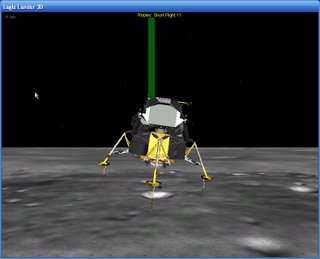 Apollo 11 mission. The final sixty seconds of the Apollo 11 descent were quite hairy, because the on-board flight computer was steering Eagle toward a field of large rocks scattered within and around a large crater. Neil Armstrong assumed manual control of the Eagle, and with Buzz Aldrin's assistance (Aldrin was calling out data from the on-board displays and the radar), guided it to a landing with approximately 15 seconds of fuel left (actually, they landed on "Empty," and only a postflight analysis was able to determine how much fuel they had left).
Apollo 11 mission. The final sixty seconds of the Apollo 11 descent were quite hairy, because the on-board flight computer was steering Eagle toward a field of large rocks scattered within and around a large crater. Neil Armstrong assumed manual control of the Eagle, and with Buzz Aldrin's assistance (Aldrin was calling out data from the on-board displays and the radar), guided it to a landing with approximately 15 seconds of fuel left (actually, they landed on "Empty," and only a postflight analysis was able to determine how much fuel they had left).
I've studied both the hardware and the surface operations of the Apollo missions extensively. However, although I understood on an intellectual level just how 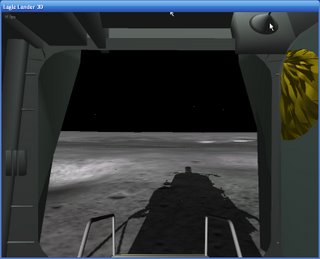 how much skill was required to land on the Moon, it wasn't until I tried this game that I fully understood just how difficult it was to guide a Lunar Module to a safe landing on Earth's “8th Continent” the first time around. As near as I can tell, the handling qualities of the Eagle are very accurately simulated, but once you get used to it, it's relatively straightforward to maneuver provided that you use a light touch on the stick.
how much skill was required to land on the Moon, it wasn't until I tried this game that I fully understood just how difficult it was to guide a Lunar Module to a safe landing on Earth's “8th Continent” the first time around. As near as I can tell, the handling qualities of the Eagle are very accurately simulated, but once you get used to it, it's relatively straightforward to maneuver provided that you use a light touch on the stick.
This game is full of nice touches. The aforementioned 3-d virtual cockpit is very well done and accurately but unobtrusively reproduces the interior of a Lunar Module. The coolest thing, though, is what happens when you safely land the 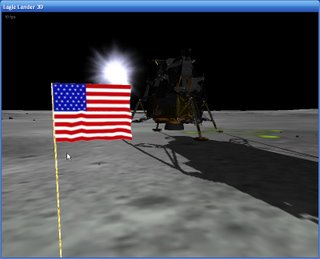 Eagle on the lunar surface: The game switches to a first person mode! You make your own journey down the ladder attached to the descent stage and explore Tranquility Base using FPS-style controls. It even simulates the "kanagaroo hops" that you experience in one-sixth gravity, so it's the closest most of us will get to the lunar surface until the first lunar hotels open up. Incredible. I really like Eagle Lander 3d, and I heartily recommend it. It's a lot of fun, and it also gives you an even bigger appreciation for the magnitude of the amazing accomplishment achieved on July 20th, 1969.
Eagle on the lunar surface: The game switches to a first person mode! You make your own journey down the ladder attached to the descent stage and explore Tranquility Base using FPS-style controls. It even simulates the "kanagaroo hops" that you experience in one-sixth gravity, so it's the closest most of us will get to the lunar surface until the first lunar hotels open up. Incredible. I really like Eagle Lander 3d, and I heartily recommend it. It's a lot of fun, and it also gives you an even bigger appreciation for the magnitude of the amazing accomplishment achieved on July 20th, 1969.
Orbiter Space Flight Simulator (Freeware; http://www.orbitersim.com)
 The Orbiter Space Flight Simulator, is a closed-source freeware space simulation platform, and the spiritual successor to Microsoft Space Simulator. This program has amazing graphics, is relatively easy to learn, and has a large and active user community that is constantly producing mods and extensions that increase the functionality of this program. Plus, you really can't argue with the price ($0). I still haven't spent much time with the new version, Orbiter 2006, but by all accounts it's a significant improvement over previous versions, including higher-resolution planetary textures.
The Orbiter Space Flight Simulator, is a closed-source freeware space simulation platform, and the spiritual successor to Microsoft Space Simulator. This program has amazing graphics, is relatively easy to learn, and has a large and active user community that is constantly producing mods and extensions that increase the functionality of this program. Plus, you really can't argue with the price ($0). I still haven't spent much time with the new version, Orbiter 2006, but by all accounts it's a significant improvement over previous versions, including higher-resolution planetary textures.
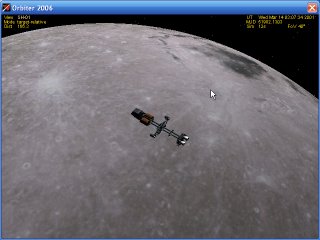 Orbiter is a significant achievement in flight simulation that I like a great deal, but like most freeware development efforts it still suffers from some minor problems [Disclaimer: these comments apply to the Orbiter 2005 version, not the new version released last month]. First and foremost, although Orbiter's greatest strength is its extensibility and customization features, the installation of mods can be a real chore that sometime requires extensive editing of text files. Minor text-editing errors can make the game crash, but tracking them down can be frustrating. I really hope that
Orbiter is a significant achievement in flight simulation that I like a great deal, but like most freeware development efforts it still suffers from some minor problems [Disclaimer: these comments apply to the Orbiter 2005 version, not the new version released last month]. First and foremost, although Orbiter's greatest strength is its extensibility and customization features, the installation of mods can be a real chore that sometime requires extensive editing of text files. Minor text-editing errors can make the game crash, but tracking them down can be frustrating. I really hope that 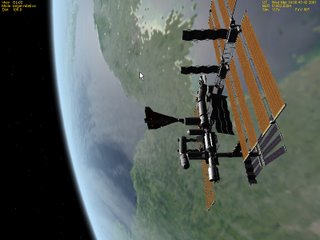 future versions of this game have a FS2004 mod-management interface. Secondly, there isn't really a Microsoft Space Simulator-style autopilot. An inspection of the Orbiter forums revealed that there are some sound physics-based reasons for not having an autopilot, but that makes it hard for beginners or users without a lot of time on their hands to get started with the game. Hopefully a fully featured autopilot will pop up in the future versions (perhaps just limited to a single vessel class). However, there are a lot of mods out there to automate things like space shuttle launches or a lunar module landings), which helps to mitigate this particular issue. At least one Orbiter autopilot project has also been started, and there are autopilot capabilities in the excellent Deltaglider III mod. Still, these minor quibbles aside, this is a great game and well worth the free download. I'm really looking forward to spending some quality time with the new version.
future versions of this game have a FS2004 mod-management interface. Secondly, there isn't really a Microsoft Space Simulator-style autopilot. An inspection of the Orbiter forums revealed that there are some sound physics-based reasons for not having an autopilot, but that makes it hard for beginners or users without a lot of time on their hands to get started with the game. Hopefully a fully featured autopilot will pop up in the future versions (perhaps just limited to a single vessel class). However, there are a lot of mods out there to automate things like space shuttle launches or a lunar module landings), which helps to mitigate this particular issue. At least one Orbiter autopilot project has also been started, and there are autopilot capabilities in the excellent Deltaglider III mod. Still, these minor quibbles aside, this is a great game and well worth the free download. I'm really looking forward to spending some quality time with the new version.
With the success of the Mars rovers, the resumption of Shuttle flights, the new Vision for Space Exploration, and most importantly, the onset of space tourism and commercial space development, space is ever-so-slowly starting to get appealing again. I therefore hope and expect that we'll see some more “solar sci-fi” PC games coming out in the next few years. Right now, the best space games available are Orbiter and Eagle Lander 3D. I doubt that we'll see a commercial equivalent for Orbiter, but I wouldn't be surprised if suborbital spaceflights appear in future versions of Microsoft Flight Simulator. There are some other games that I'd actually like to see more, though, including a modern remake of BARIS, perhaps with the planning of a Mars settlement effort instead of the space race-era lunar missions. I'd also really, really like to see a full-blown Civilization in Space game, where your job as the leader of a nation on Earth is to economically develop cislunar space as well as to establish independent colonies on the Moon, Mars, and asteroids--like Alien Legacy, but in our own solar system.

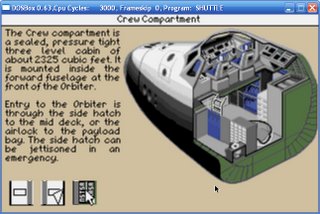




An excellent article.... and -really- I'll never forget the manual of Shuttle...
ReplyDeleteJust re-read it.
ReplyDeleteStill an excellent article...
Thanks so much!
ReplyDeleteYes, Shuttle was an amazing achievement, especially for 1992. You could even chuck the hefty manual and use NASA checklists and manuals instead, and all of the procedures and command functions were still valid--and they put it all onto three 1.2 MB disks.